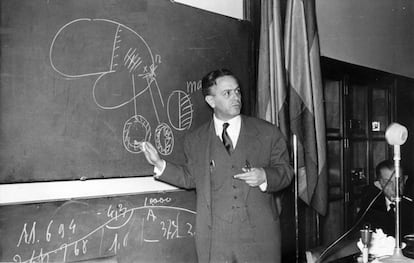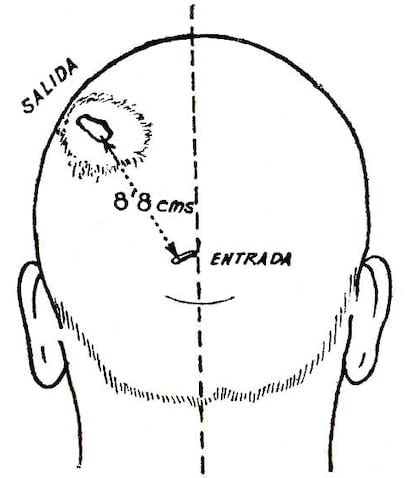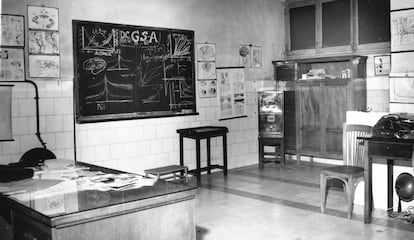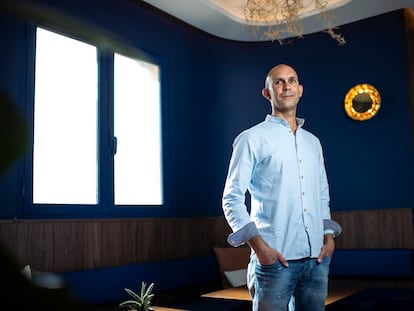Patient M: The man who started seeing the world backwards after being shot in the head
A study returns to the case of a soldier injured during the Spanish Civil War who inspired doctor Justo Gonzalo’s theory of the human brain

On a spring day in 1938, a 25-year-old man was left lying on the ground. A projectile had crossed his head on the Valencian front of the Spanish Civil War. When he recovered consciousness two weeks later, the Republican soldier had experienced a shocking change: under certain conditions, he saw the world backwards. The 28-year-old doctor Justo Gonzalo attended the patient in a nearby military hospital. The projectile, probably shot by the Francoists, had partially destroyed the ridges on his cerebral cortex in the left parieto-occipital region. The wounded man, however, survived miraculously, without needing operations or special care. Gonzalo, born in Barcelona in 1910, realized that the unique case — who he called Patient M — could illuminate the functioning of the human brain.
The doctor and M survived the war and continued seeing each other for almost half a century, until Justo Gonzalo’s death in 1986. The researcher’s daughter Isabel Gonzalo has dusted off her father’s archives — boxes with hundreds of documents and photos — to rediscover the case, alongside the neuropsychologist Alberto García Molina. At a time when the scientific community was divided between those who see the brain as a whole, and those who draw hard boundaries between the brain regions, Gonzalo proposed an intermediate hypothesis based on Patient M: the theory of brain dynamics, according to which the organ has its functions distributed in gradients, with gradual transitions.
Isabel Gonzalo, who is a physicist and professor emeritus at the Complutense University of Madrid, met Patient M during his visits to the family’s home. The man had been born in a village in the Spanish municipality of Ciudad Real. When he was resting, without major stimuli, he saw a terrifying backwards world, in which objects appeared in triplicate and tinged green. His auditory and tactile perception were also inverted, so that sounds and touches appeared in his mind on the opposite side. “M looked at his wristwatch from any direction to check the time,” Isabel remembers. The details of the case have been published in the journal Neurologia.

At the beginning of the 20th century, Spain was a luminary in studies of the human brain. The researcher Santiago Ramón y Cajal had demonstrated in 1888 that the thinking organ was not a diffuse mass, as had been previously believed, but rather that it was organized into individual cells: neurons. Cajal won the Nobel Prize in Medicine for his discovery in 1906. Around him grew a school of talented disciples, like the neurologist Gonzalo Rodríguez Lafora, who, when the Civil War broke out, recruited Justo Gonzalo to work with him in his Skull Trauma Center. There, Gonzalo, Cajal’s academic descendant, met Patient M and hundreds of other wounded patients. The patients’ adaptive capability was astonishing, as the doctor described in his book Cerebral Dynamics, published in two volumes between 1945 and 1950. M “had found his abnormalities strange when, for example, he saw men working upside down on a scaffold,” Gonzalo wrote. “In general, the disturbances go completely or almost completely unnoticed to the wounded. Later, when they discover them, they don’t seem to worry, but rather consider them as something temporary that does not affect or compromise their daily life.” M tended to downplay his symptoms: “They are things that sometimes appear in my vision.”
Neuropsychologist Alberto García Molina works at the Institut Guttmann, a hospital in Barcelona specialized in rehabilitation of people with brain damage. The researcher emphasizes that the history of neurology is full of tragic natural experiments, like that of Phineas Gage, an American railroad captain who survived an iron rod being driven through his brain on September 13, 1848. The formerly calm man became aggressive and vulgar. British doctor David Ferrier mentioned Gage’s case in his 1878 lecture “The Localization of Cerebral Disease,” in which he pioneered the association of concrete functions to specific areas of the cerebral cortex.

García Molina explains that, in the 1930s, the modular perspective remained dominant. “The brain was seen like little boxes. When you altered a box, supposedly there was a concrete deficit,” the neuropsychologist explains. “For Dr. Gonzalo, the modular theories couldn’t explain the questions that emerged with Patient M, so he began to create his theory of brain dynamics, breaking with the hegemonic vision about how the brain works.”
The war brought a turn in Justo Gonzalo’s scientific career. He had studied at the University of Vienna in 1934 and at the Goethe University of Frankfort in 1935, at the height of Naziism in Germany. After the July 1936 coup in Spain, he remained faithful to the Republic during the Civil War and even worked as a doctor in a battalion, under the command of communist officer Enrique Líster. Gonzalo’s mother joked about the new lifestyle of her son, who had previously spent all his time in the library: “Thanks to the war, Justito is finally getting some air,” she told family members.
In 1952, the doctor became part of the Cajal Institute in Madrid, where he continued attending to 200 brain injury patients who were registered in the Honorable Corps for the Mutilated in the War for the Fatherland, which excluded the wounded who fought on the Republican side. Letters between M and Gonzalo confirmed that the man who saw the world backwards had not received a pension as a wounded veteran. “My father admired him, because he was a very bright person who was capable of taking care of himself and working in the fields,” Isabel Gonzalo remembers. The physicist calculates that M died in the late 1990s. The identity of the man, who helped illuminate the functioning of the human brain, was never made known.
Sign up for our weekly newsletter to get more English-language news coverage from EL PAÍS USA Edition
Tu suscripción se está usando en otro dispositivo
¿Quieres añadir otro usuario a tu suscripción?
Si continúas leyendo en este dispositivo, no se podrá leer en el otro.
FlechaTu suscripción se está usando en otro dispositivo y solo puedes acceder a EL PAÍS desde un dispositivo a la vez.
Si quieres compartir tu cuenta, cambia tu suscripción a la modalidad Premium, así podrás añadir otro usuario. Cada uno accederá con su propia cuenta de email, lo que os permitirá personalizar vuestra experiencia en EL PAÍS.
¿Tienes una suscripción de empresa? Accede aquí para contratar más cuentas.
En el caso de no saber quién está usando tu cuenta, te recomendamos cambiar tu contraseña aquí.
Si decides continuar compartiendo tu cuenta, este mensaje se mostrará en tu dispositivo y en el de la otra persona que está usando tu cuenta de forma indefinida, afectando a tu experiencia de lectura. Puedes consultar aquí los términos y condiciones de la suscripción digital.
More information
Archived In
Últimas noticias
Human rights activists, opposition members, and a minor: Maduro’s other political prisoners
Israel sparks a civil war within the MAGA movement
The complicated life of Francesca Albanese: A rising figure in Italy but barred from every bank by Trump’s sanctions
Pinochet’s victims grapple with José Antonio Kast’s rise in Chile
Most viewed
- Reinhard Genzel, Nobel laureate in physics: ‘One-minute videos will never give you the truth’
- Pablo Escobar’s hippos: A serious environmental problem, 40 years on
- Charles Dubouloz, mountaineering star, retires at 36 with a farewell tour inspired by Walter Bonatti
- Why we lost the habit of sleeping in two segments and how that changed our sense of time
- The Florida Keys tourist paradise is besieged by immigration agents: ‘We’ve never seen anything like this’










































